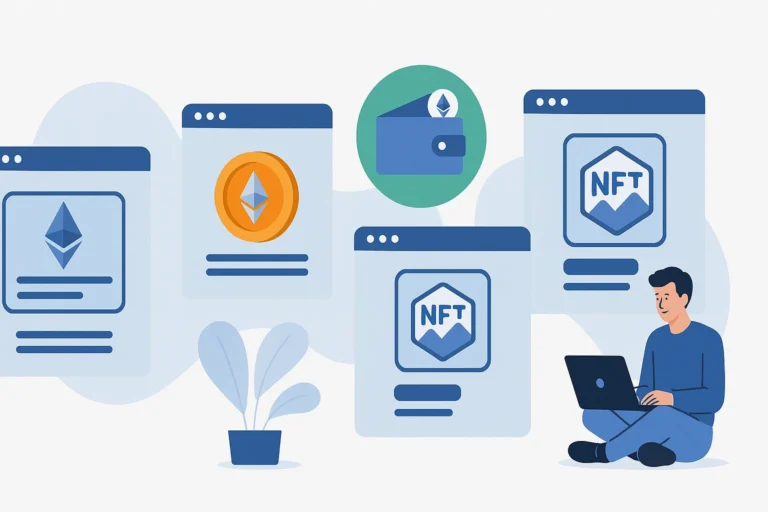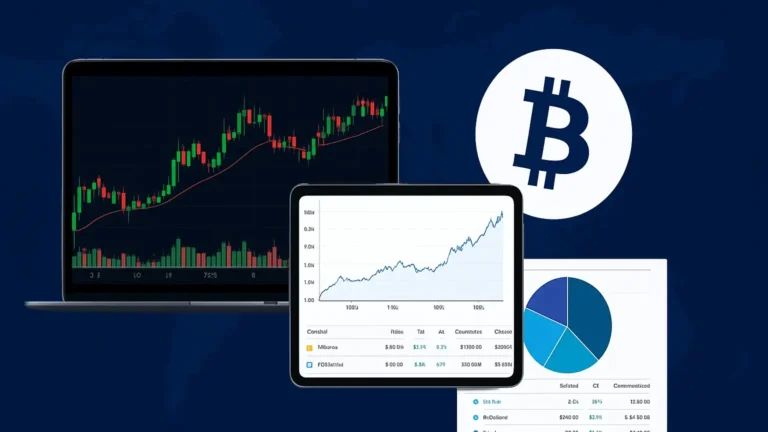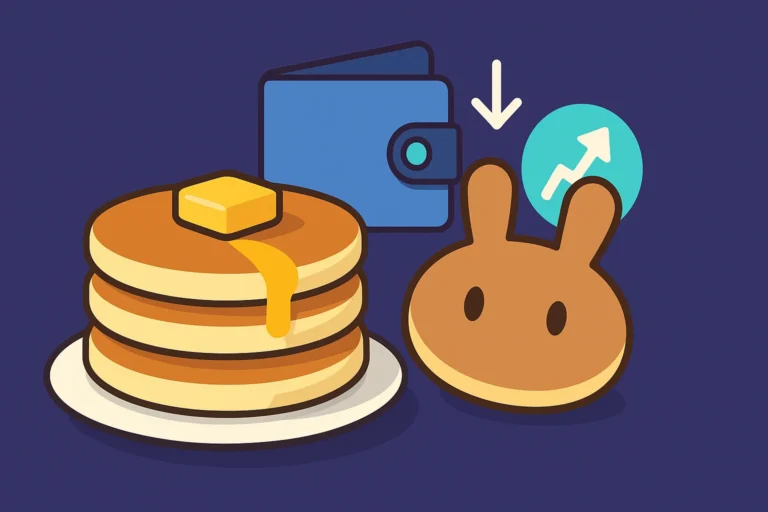Leverage Trading Crypto Explained: A Complete Beginner’s Guide (2025)

Leverage Trading Crypto Explained
Hey.. Traders
Cryptocurrency trading has revolutionized the financial world, and leverage trading is one of the hottest tools attracting traders worldwide.
But what does it really mean? And is it a golden ticket to profit or a fast track to liquidation?
This in-depth guide is crafted to break down leverage trading in crypto, from the basics to advanced techniques.
Whether you’re a curious beginner or an experienced trader wanting to refine your game, this guide will walk you through everything you need to know. Let’s dive in and decode the art of multiplying your crypto gains or losses, with leverage trading.
What is Leverage Trading in Crypto?
The Concept of Leverage
At its core, leverage trading means borrowing money to amplify your position in a trade. Imagine being able to buy $1,000 worth of Bitcoin with just $100 of your own money. Sounds great, right? That’s leverage at work.
Leverage is expressed as a ratio, like 2x, 5x, or 100x. If you’re trading with 10x leverage, you’re borrowing 90% of the position value. That means even a small move in the price can give you outsized gains or losses.
This concept is borrowed (pun intended) from traditional financial markets, but in the crypto world, the stakes are even higher due to the extreme volatility. Some platforms allow you to go up to 125x leverage, which means for every $1, you’re controlling $125. One wrong move, and you could be wiped out in seconds.
How It Works in the Crypto Market
Let’s make it practical. Suppose any crypto is trading at $30,000, and you have $1,000. With 10x leverage, you can open a position worth $10,000.
If BTC moves up by 5%, your gain is $500 on a $1,000 investment pretty sweet!
However, if BTC drops by just 5%, you lose $500. With higher leverage, even a 1% price swing can liquidate your entire position. This is why leverage is often dubbed a double-edged sword.
In the crypto world, leverage trading often takes place through derivatives like perpetual contracts or futures, not actual crypto purchases.
You’re speculating on price movement, not owning the asset. This makes leverage trading highly strategic, and if you are not careful, incredibly risky.
Understanding the Basics of Leverage Ratios
Common Leverage Ratios in Crypto Trading
Crypto exchanges usually offer a wide range of leverage options. Here are some commonly seen ratios:
- 2x to 5x – Considered low leverage. Suitable for beginners and conservative strategies.
- 10x to 20x – Medium leverage. Offers good potential but higher risk.
- 50x to 125x – High leverage. High risk, mostly used by pros or high-stakes gamblers.
Different exchanges have different limits. For example, Binance might offer up to 125x on BTC pairs, but only 20x or 50x for altcoins. This is because altcoins are more volatile and prone to massive swings.
It’s important to remember: the higher the leverage, the tighter the margin of error. One small price move against your position, and you’re out.
Example Scenarios of Leverage in Action
Let’s walk through two real-world style examples to show the power and danger of leverage:
Scenario 1: Win with 10x Leverage
- You have $500.
- BTC is at $30,000. (This example only, Current price is above 100000$ above)
- You open a long position at 10x leverage ($5,000 total).
- BTC moves up by 10% – BTC now at $33,000.
- Your position is now worth $5,500.
- You close the trade and profit $500 doubling your money.
Scenario 2: Liquidated at 20x Leverage
- You have $1,000.
- ETH is at $2,000.
- You open a long at 20x leverage ($20,000 position).
- ETH drops by 5% to $1,900.
- Your position loses $1,000.
- You’re liquidated. Your capital is gone.
These examples illustrate why it is crucial to manage your risk and use leverage responsibly. It is not about winning every time, it is about surviving to trade another day.
Benefits of Leverage Trading in Cryptocurrency
Maximizing Profit Potential
Let’s be honest: everyone wants to make more money in less time. That is the siren song of leverage trading. When used wisely, it can amplify profits significantly without needing massive capital.
You can:
- Grow your portfolio faster.
- Take advantage of small price movements.
- Trade more assets simultaneously by dividing your capital.
This is especially helpful in a market like crypto, where volatility is the norm. Instead of waiting for a 20% move, you can profit off a 2% move using 10x leverage.
Also, you can free up capital for other investments while maintaining larger positions. Smart traders use leverage as a tool to diversify their exposure while optimizing for return on investment.
Diversification with Limited Capital
With leverage, your $1,000 is not limited to one trade. You can split it into 5 trades of $1,000 each with 5x leverage. That means you’re not all-in on one coin.
You can long BTC, short ETH, hedge with a stablecoin, and experiment with altcoins all without needing $5,000 in your account.
It offers flexibility, adaptability, and power if used with discipline.
Major Risks Involved in Leverage Trading
Liquidation and Margin Calls
Here is the hard truth: leverage can make you go broke in minutes.
When you trade on leverage, you’re borrowing money. If the trade goes against you beyond a certain threshold, your position gets liquidated closed automatically by the exchange. That means your capital is gone.
Margin calls are another nightmare. If your margin (your own money in the trade) falls below a certain level, the platform might ask you to add more funds or face liquidation. It’s stressful, fast-paced, and sometimes unpredictable.
These risks increase with:
- Higher leverage
- Low account balance
- Volatile assets (like meme coins or small-cap altcoins)
Emotional and Financial Stress
Leverage trading is not for the faint of heart. Watching your portfolio fluctuate wildly can induce panic, anxiety, and FOMO. Traders often overreact, leading to bad decisions like doubling down or revenge trading.
This emotional rollercoaster can be financially devastating. Always trade with a clear plan, defined stop losses, and never with money you can not afford to lose.
How to Start Leverage Trading in Crypto Safely
Choose the Right Exchange
Your first step into leverage trading starts with selecting a reputable, secure, and user-friendly crypto exchange.
Not all platforms are built the same, and each offers different features, leverage limits, fees, and protections. You need to be picky here because your trading experience and safety depends on it.
Some of the most trusted exchanges for leverage trading in 2025 include:
- Binance – Offers up to 125x leverage on selected assets, high liquidity, and robust features.
- Bybit – Known for fast execution speeds, a clean interface, and up to 100x leverage.
- Kraken – More conservative with up to 5x leverage, but highly regulated and secure.
- Bitget & OKX – Gaining popularity with competitive leverage and intuitive platforms.
- Delta Exchange – If you are from india, and want to trading in future with indian regulations.
Before committing, check these critical factors:
- Regulatory compliance in your country.
- Asset coverage – Does it support your preferred crypto pairs?
- Insurance protection – Some exchanges have user fund protection in case of breaches.
- Risk control tools – Look for stop-loss, take-profit, and cross-isolated margin modes.
Trust is key. Don’t just go for the highest leverage go for the most balanced offering between opportunity and safety.
Understand Margin Requirements and Terms
Leverage trading comes with a glossary of terms you must understand before placing your first trade. If you skip this, you’re walking into a casino blindfolded.
Here are the big ones:
- Initial Margin – The minimum capital required to open a position.
- Maintenance Margin – The capital you need to maintain the position. Fall below this, and you risk liquidation.
- Liquidation Price – The price point at which your position is automatically closed.
- PnL (Profit and Loss) – Shows your gains or losses in real-time.
Also understand cross margin (your entire balance backs the position) vs. isolated margin (only the margin for that trade is at risk). Beginners should always start with isolated margin to contain losses.
Take time to read the fine print of your chosen platform. Many offer demo or testnet trading environments where you can practice without using real money use them.
Best Crypto Exchanges for Leverage Trading in 2025
Binance, Bybit, Delta and Others Compared
Let’s break down some of the top choices for leverage trading based on user experience, leverage limits, fees, and reliability. Here is a comparative table to help:
| Exchange | Max Leverage | Key Strengths | Known Weaknesses |
|---|---|---|---|
| Binance | Up to 125x | High liquidity, low fees, feature-rich | Complex interface for beginners |
| Delta Exchange | Up to 200x | Regulatory compliance, high trust | Better for beginners. Better for India. |
| Bybit | Up to 100x | Intuitive UI, fast trades, mobile app | Restricted in some countries |
| Bitget | Up to 100x | Copy trading, beginner-friendly UI | Still growing brand trust |
| OKX | Up to 100x | Wide coin range, robust tools | Occasional withdrawal delays |
| Kraken | Up to 5x | Regulatory compliance, high trust | Low leverage, limited pairs |
Each platform has its pros and cons. For serious leverage traders, Binance and Bybit are top picks. For more cautious users, Kraken might be a better fit. If you are from INDIA then Delta exchange is better.
Factors to Consider Before Choosing
When choosing your trading home, think beyond just leverage limits. Ask yourself:
- How intuitive is the interface? You don’t want to get lost during a live trade.
- What’s the fee structure? Some exchanges charge taker/maker fees, overnight interest, or funding rates.
- Is it accessible in your country? Legal restrictions matter.
- Does it offer customer support? Live chat and help centers are lifesavers during issues.
Your exchange should feel like a partner, not a risk. Take your time before funding your account.
Margin Trading vs. Leverage Trading
Differences Explained Simply
People often use the terms margin trading and leverage trading interchangeably, but there’s a subtle difference worth noting.
- Margin Trading involves borrowing funds to increase your position size. You put up collateral (margin), and the exchange lends you the rest.
- Leverage Trading is the result of margin trading. it is the effect of using borrowed funds to amplify trade size.
Think of margin as the “how,” and leverage as the “result.”
In crypto, most platforms refer to leveraged trades as margin trading, especially when you trade perpetual futures or derivatives. But the key takeaway is- both mean you’re trading more than you own using borrowed money.
Which One is Right for You?
If you’re risk-averse and new to trading, low-leverage margin trading (like 2x to 5x) is a safer place to start. It lets you learn how trades behave under pressure without wiping your account on a 2% price move.
If you’re more experienced, you might explore higher leverage for short-term plays or scalping strategies. Just remember: higher leverage doesn’t always mean higher profits, it often means faster losses.
The right choice depends on:
- Your risk appetite
- Your trading experience
- Your emotional discipline
- Your understanding of market indicators
There’s no one size fits-all answer. Test, evaluate, and adjust.
Advanced Strategies for Leverage Trading
Hedging, Shorting, and Scalping
Once you have mastered the basics, it is time to level up with advanced strategies that can give you an edge.
Hedging
Use leverage to hedge against losses in your spot portfolio. For example, if you hold BTC, you can open a short leveraged position to protect your downside during a dip. It’s like buying insurance for your portfolio.
Shorting
Leverage allows you to profit when the market drops. You “sell” high and “buy” low later to close the trade. This is essential in bear markets or when you expect corrections.
Scalping
Scalping involves making multiple small trades in short timeframes. Leverage amplifies each move, so small profits stack up fast. But beware it also means small mistakes pile up.
These strategies are powerful but require fast execution, constant monitoring, and strong discipline. One lapse, and your portfolio could bleed.
Risk Management with Stop-Loss and Take-Profit
If you take nothing else from this article, remember this: risk management is everything in leverage trading.
Set your:
- Stop-loss – Automatically exits the trade when losses hit a pre-defined level.
- Take-profit – Locks in profits when price hits your target.
Never enter a leveraged position without both. Even experienced traders make mistakes, but what keeps them alive is strict discipline with risk controls.
Some golden rules:
Keep emotions out of trading let your strategy do the work.
Never risk more than 1–2% of your total capital per trade.
Always use isolated margin unless you’re confident.
Mistakes to Avoid in Crypto Leverage Trading
Over-Leveraging
Let’s face it high leverage is tempting. It promises big rewards with small capital. But that temptation is where most traders get wrecked.
Over-leveraging is when you use more leverage than your trading experience, capital, or strategy can handle. New traders often jump in with 50x or 100x leverage, thinking a quick win will make them rich. Reality check? That 1% price dip can wipe them out.
Why does this happen so often?
- Greed – Chasing quick profits without planning.
- Lack of education – Not understanding liquidation mechanics.
- Overconfidence – Believing you’ve cracked the market after one win.
It’s a trap. High leverage doesn’t just magnify profits, it supercharges risk. Even veteran traders use high leverage cautiously, often for short-term scalps with tight stop-losses.
A safer approach:
- Start with 2x to 5x leverage.
- Test strategies on demo accounts first.
- Focus on survival, not jackpot wins.
Your goal is long-term consistency, not lottery-style payouts.
Ignoring Risk Management
Here’s a hard truth: If you don’t manage your risk, the market will do it for you, and it won’t be kind.
New traders often enter positions with no stop loss, no plan, and way too much capital in play. That’s not trading. That is gambling.
Some critical mistakes to avoid:
- Not setting stop-loss orders
- Risking too much per trade
- Doubling down on losing trades
- Trading emotionally after a loss (revenge trading)
Create a plan before the trade:
- Entry point
- Exit plan (both stop-loss and take-profit)
- Position sizing
- Maximum capital exposure
Stick to it. The most successful traders don’t win every trade, they manage risk so that when they lose, they lose small. That’s how they stay in the game.
Tools and Indicators Useful in Leverage Trading
RSI, MACD, Moving Averages
Technical indicators can be your best friends in leverage trading. They give you insights into price momentum, trend strength, and potential reversals. Used wisely, they help you make smarter, faster decisions.
RSI (Relative Strength Index)
Measures whether a coin is overbought or oversold. On a scale of 0 to 100:
- Above 70 = Overbought (possible price drop)
- Below 30 = Oversold (possible price rise)
Perfect for timing entries and exits during fast market moves.
MACD (Moving Average Convergence Divergence)
Tracks changes in momentum and identifies trend reversals. Great for spotting bullish or bearish crossovers.
Moving Averages (SMA & EMA)
These smooth out price action. The 50-day and 200-day moving averages are popular. Crossovers can signal entry or exit points.
Use a combination of indicators to confirm your trades. Don’t rely on just one. Also, adjust timeframes based on your strategy (scalping vs. swing trading).
Trading Bots and Alerts
Tech tools can add serious firepower to your leverage trading.
- Trading Bots – Automate strategies based on indicators. Great for 24/7 execution.
- Price Alerts – Notify you when an asset hits your target or risk level.
- Portfolio Trackers – Help you analyze PnL, drawdown, and risk-reward ratios.
These tools don’t replace your brain, but they help your brain move faster and more efficiently. Think of them as assistants, not pilots.
Tax Implications of Leverage Trading Crypto
Reporting Profits and Losses
Most countries now treat crypto trading as a taxable event. That includes leveraged trades. Whether you win or lose, you may be required to report it.
Key tax events:
- Profits from trades – Counted as capital gains.
- Losses from liquidation – Can often be deducted against gains.
- Fees paid on exchanges – In many regions, these are deductible.
Keep track of every trade. Use crypto tax software like:
- CoinTracker
- Koinly
- TokenTax
They import data from exchanges and generate tax reports automatically.
Failing to report crypto profits can result in penalties or audits. Don’t risk it.
How Regulations Vary by Country
Different countries treat leverage trading differently. Here are a few snapshots:
- USA – Strict regulations; many platforms are restricted. IRS demands full crypto disclosures.
- UK – Capital gains tax applies. FCA bans certain crypto derivatives for retail traders.
- Germany – Favorable for long-term holders, but short-term leveraged trades are taxed.
- India – High tax rates; leverage trading is legal but often scrutinized. 30% tax on crypto. In delta exchange you can trade without buying crypto.
- Australia & Canada – Must report crypto activity; leverage adds complexity.
Before trading, check your local laws or consult a tax professional. What’s legal and profitable in one country might be restricted in another.
Leverage Trading Crypto for Beginners
Step-by-Step Walkthrough
Here’s a simplified walkthrough to get you started with leverage trading safely:
- Pick a Reputable Exchange – Start with a beginner-friendly one like Bybit or Binance.
- Create and Verify Your Account – Complete KYC (Know Your Customer) steps.
- Deposit Funds – Use stablecoins like USDT or direct fiat deposits.
- Select Leverage Carefully – Start with 2x or 3x leverage.
- Choose Isolated Margin – Reduces risk to only that trade.
- Do Technical Analysis – Use RSI, MACD, or moving averages for decision-making.
- Set Stop-Loss and Take-Profit – Define your risk before entering.
- Monitor the Trade – Keep emotions in check. Don’t panic.
- Exit Smartly – Stick to your plan. Don’t get greedy.
Practice makes perfect. Start small, stay disciplined, and build experience before taking big swings.
Do’s and Don’ts for New Traders
Do’s
- Educate yourself constantly
- Use low leverage until you’re confident
- Always set a stop-loss
- Diversify your trades
Don’ts
- Don’t chase losses
- Don’t trade without a strategy
- Don’t over-leverage
- Don’t trade emotionally
Treat trading like a business, not a lottery. The more structured your approach, the better your outcomes.
Common Terms You Must Know
Liquidation Price, Margin, Maintenance Margin
The world of leverage trading in crypto is full of jargon. Let’s simplify the most essential terms you’ll need to navigate it like a pro.
Liquidation Price
This is the price at which your leveraged position gets automatically closed by the exchange due to insufficient margin. For example, if you enter a 10x long on Bitcoin at $30,000 with $1,000 capital, your liquidation price might be $27,000. If BTC falls to that price, your trade is forcibly closed, and your capital is gone.
Margin
This is the amount of money you commit from your own wallet to open a leveraged position. It acts as collateral for the borrowed amount. Margin requirements vary based on leverage and asset volatility.
- Initial Margin – The upfront cost to enter the trade.
- Maintenance Margin – The minimum amount required to keep the trade open.
PnL (Profit and Loss)
This tracks how much money you have made or lost in a trade. Realized PnL is the profit or loss when you close a trade. Unrealized PnL is what you’d gain or lose if you closed it right now.
Funding Rate
In perpetual futures trading, funding rates help keep the contract’s price close to the spot price. Depending on the rate, you may either pay or receive a fee periodically. These rates are small but can add up, especially on high leverage trades.
These terms are foundational. The more fluent you become in this lingo, the more confident you will feel executing trades in real time.
Future Trends in Crypto Leverage Trading
Institutional Adoption and Tech Improvements
Leverage trading is not just for retail investors anymore. Institutional traders are jumping in, bringing more liquidity, advanced tools, and smarter strategies to the space.
What’s Changing?
- Better Infrastructure – Faster order execution, lower slippage, enhanced security.
- Institutional-Grade Platforms – Products like CME Futures or Coinbase Pro cater to big players.
- Advanced Risk Management Systems – AI powered bots and algorithms are reshaping trade execution and position monitoring.
These upgrades benefit retail traders too, especially on platforms that democratize institutional-level tools.
Regulatory Evolution and What It Means
Governments are catching up with the speed of crypto innovation. As leverage trading gains popularity, more regulations are inevitable.
Possible Outcomes:
- Caps on maximum leverage – Like the EU capping leverage for retail FX traders.
- Mandatory KYC/AML compliance – Anonymous high-leverage trading may fade.
- Higher reporting requirements – Exchanges may need to report users’ gains and losses to tax authorities.
While regulations can seem restrictive, they also create trust, reduce scams, and pave the way for mass adoption. Expect clearer rules, safer platforms, and a more mature ecosystem in the years to come.
Conclusion
Leverage trading in crypto can be both a powerful. When used responsibly, it unlocks opportunities that simply don’t exist in traditional spot trading. But misuse it, even slightly and the consequences can be brutal.
You’ve now explored:
- What leverage trading is and how it works
- Its risks, rewards, and real-life examples
- How to choose the right platform and strategies
- Tools and terms that make you a smarter trader
- What the future of leverage trading looks like
Remember, leverage trading is not for everyone. It requires discipline, strategy, and emotional control. It’s not about guessing right every time, it is about managing risk and staying consistent.
If you treat it like a business, respect your capital, and stay educated, you will have a far better shot at becoming not just a trader but a successful one.
FAQs
Is leverage trading in crypto good for beginners?
Not really. Beginners should first master spot trading. Leverage introduces more risk, complexity, and emotions. Start with demo accounts or small leverage (2x–3x) only after understanding market movements and technical analysis.
What’s the safest leverage to use in crypto trading?
2x to 5x is considered the safest range for most traders. It gives some profit potential while keeping risks manageable. Anything above 10x is best left to experienced traders with strong strategies.
Can I get liquidated using 2x leverage?
Yes, but the risk is lower. With 2x leverage, prices need to move significantly against your position for liquidation to occur. However, it’s still possible if the market is volatile and you don’t use stop-losses.
Do I need to pay interest on leveraged trades?
Yes. Exchanges charge fees on borrowed funds, often daily. In futures trading, you may also pay or receive funding rates, depending on market conditions. Always check the fee structure before trading.
Which crypto exchanges offer the highest leverage?
As of 2025, Binance and Bybit offer the highest leverage, up to 125x for select assets. Also delta india have 200x leverage in BTC. However, such high leverage is extremely risky and rarely recommended for non-professional traders.
Contents
- 1 Leverage Trading Crypto Explained
- 2 What is Leverage Trading in Crypto?
- 3 Understanding the Basics of Leverage Ratios
- 4 Benefits of Leverage Trading in Cryptocurrency
- 5 Major Risks Involved in Leverage Trading
- 6 How to Start Leverage Trading in Crypto Safely
- 7 Best Crypto Exchanges for Leverage Trading in 2025
- 8 Margin Trading vs. Leverage Trading
- 9 Advanced Strategies for Leverage Trading
- 10 Mistakes to Avoid in Crypto Leverage Trading
- 11 Tools and Indicators Useful in Leverage Trading
- 12 Tax Implications of Leverage Trading Crypto
- 13 Leverage Trading Crypto for Beginners
- 14 Common Terms You Must Know
- 15 Future Trends in Crypto Leverage Trading
- 16 Conclusion
- 17 FAQs






